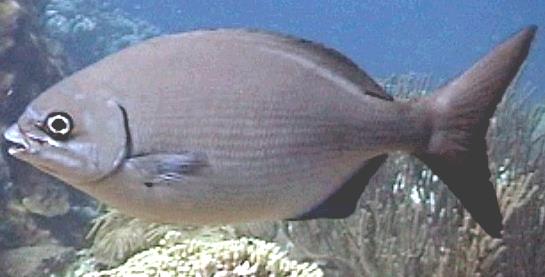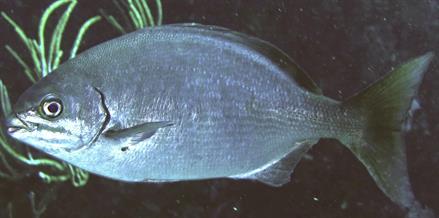



Kyphosus sectatrix
| Ecological Descriptors | ||||
| Habitat | Size (cm) | Diet | Behaviour | Sex |
| Pel (Co, S) |
30 (to 75) | Veg (Cru, Mol) | Sh | F |
Description:
Body more or less rounded/ discoid in outline (shape of a rugby/ American football). Body uniformly gray to silver, more or less rounded in outline, but with thin yellow to bronze stripes on the body and a stripe, bordered in white, under eye from the mouth to the gill cover. Upper part of the opercular membrane blackish. Angle of anal fin is less tight than Brassy Chub (K. vagiensis), but less than 90o.
Can exhibit a colour phase of dark brown, with pale polka dots.
Ecology
Inhabits shallow waters, over seagrass beds, sand or rocky bottoms and around coral reefs, down to 30m (100ft). Young chub are found among floating sargassum weeds. Feeds on plants, mainly on benthic algae, as well as small crabs and molluscs.
Life Cycle:
During each month of the spawning season, chubs are most abundant starting the day of the full moon; group size increases as fish move through the day toward core spawning sites, typically exceeding a group of more than 150 individuals. It displays distinctive colour patterns during spawning
Body more or less rounded/ discoid in outline (shape of a rugby/ American football). Body uniformly gray to silver, more or less rounded in outline, but with thin yellow to bronze stripes on the body and a stripe, bordered in white, under eye from the mouth to the gill cover. Upper part of the opercular membrane blackish. Angle of anal fin is less tight than Brassy Chub (K. vagiensis), but less than 90o.
Can exhibit a colour phase of dark brown, with pale polka dots.
Ecology
Inhabits shallow waters, over seagrass beds, sand or rocky bottoms and around coral reefs, down to 30m (100ft). Young chub are found among floating sargassum weeds. Feeds on plants, mainly on benthic algae, as well as small crabs and molluscs.
Life Cycle:
During each month of the spawning season, chubs are most abundant starting the day of the full moon; group size increases as fish move through the day toward core spawning sites, typically exceeding a group of more than 150 individuals. It displays distinctive colour patterns during spawning
Identification and Differentiation:
The Bermuda Chub (K. sectatrix) and Grey Chub (K. biggibus) are almost indistinguisable visually (gill raker count needed). However, note that Grey Chubs have not been previously reported this far East in the Caribbean.
The Bermuda Chub (K. sectatrix) and Grey Chub (K. biggibus) are almost indistinguisable visually (gill raker count needed). However, note that Grey Chubs have not been previously reported this far East in the Caribbean.
Bermuda Chub


Synonyms - Bermuda Chub:
Pacific Chub
Beaked Chub
Grey Drummer
Pacific Chub
Beaked Chub
Grey Drummer
Bermuda Chub





(C) De Kluijver

374

505
Bermuda Chub
dark with pale spots phase
dark with pale spots phase

